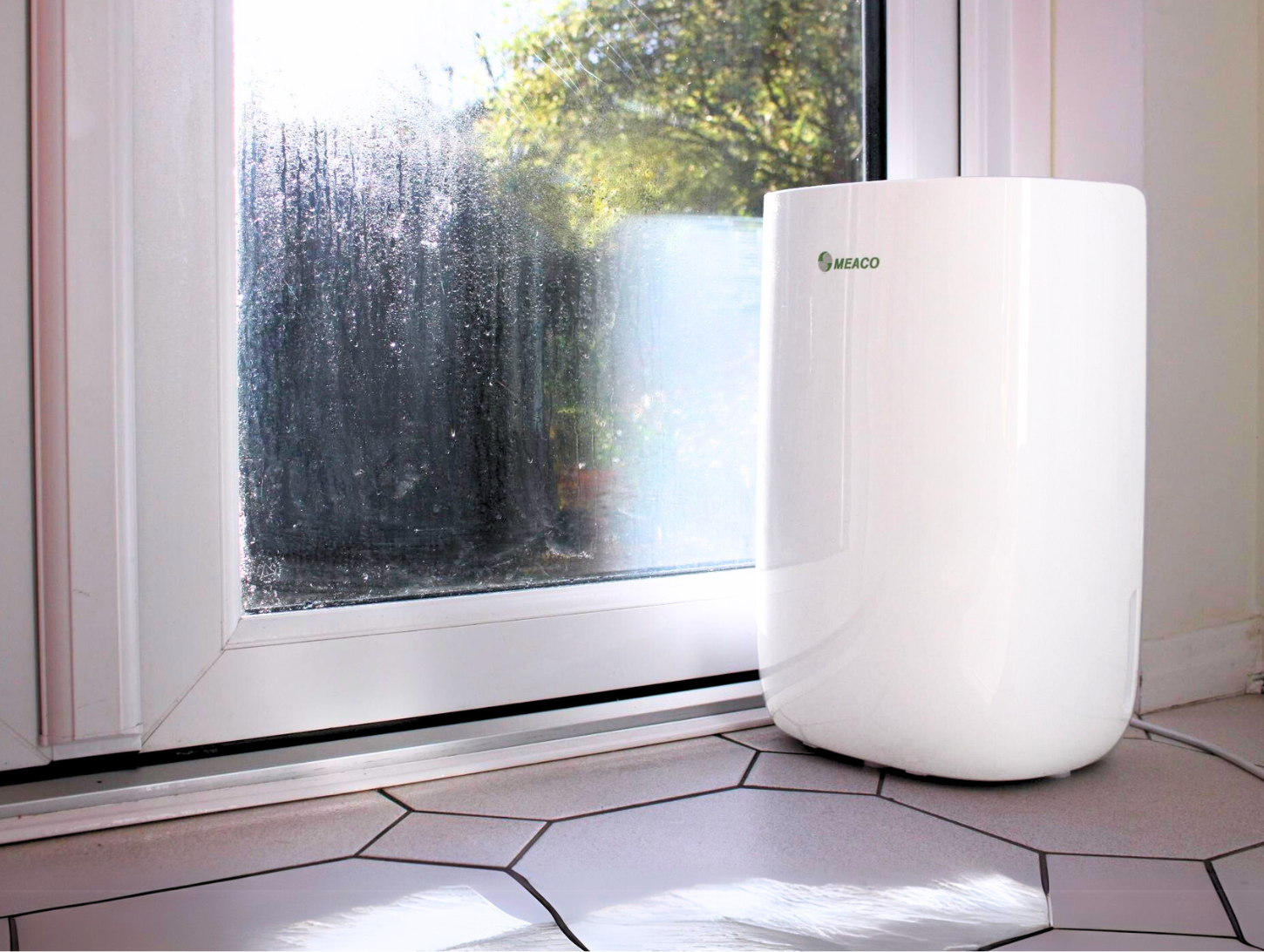
With the cold, there’s also condensation. When the temperature drops outside, generally below 5°C overnight, you’ll start seeing condensation on your windows. You may notice this most in the bedroom, kitchen, bathroom or conservatory, especially early in the morning. Stopping condensation is one of the biggest problems homeowners face.
So, how can you stop condensation? The two main approaches to ‘curing’ or ‘stopping’ condensation are either to open the windows or use a dehumidifier. Open the windows may give pretty instant results but we’re letting in the cold air and then paying to heat it back up. Dehumidifiers provide a fast, effective and cost-efficient way to manage condensation.
Opening windows to deal with condensation
You would probably expect me to recommend that you buy a dehumidifier. I am a dehumidifier manufacturer after all. But let’s look at the benefits of opening windows first.
In Germany, they call it “Stoßlüften”, meaning “shock ventilation” and they may have the right idea about things… When people worry about condensation or mould problems, the advice will often be to open the window. This is to improve ventilation.
However, in some older properties that are often quite ‘leaky’, we can see that condensation is rarely an issue. I mean that in properties with older windows, we don’t always see more condensation. These windows might let in some moisture and may not be fully draft-proof. However, condensation is about trapped moisture inside the house, not extra moisture coming in.
Opening windows can cure condensation – but do you want to let the cold in?
So why does ventilation help? Opening windows can stop condensation – but do you want to let the cold in?
First, what causes condensation on windows?
Essentially, condensation occurs when air meets a cold surface and forms water on that surface. And it’s all about the relationship between relative humidity and temperature. In most cases, the surface is the cold glass panes of your windows and the relative humidity is moisture within your home. It doesn’t matter how little moisture there is in the air – if the surface is cold enough, you will get condensation.
Your windows provide the perfect cold surface because they are in direct contact with the chilly outside. If you touch the window pane, you’ll feel the difference!
This is why my windows at home have been free of condensation for months. Now the temperature has dropped, I can suddenly see condensation. I doubt that the amount of moisture in the air in my home has increased. It is just that the surface temperature of the window is lower during a cold spell.
This is also why you’ll find double-glazed windows usually have less condensation than single-glazed ones. This is because the two panes form an insulated barrier. And as a result, the inside pane isn’t quite as cold and condensation is less likely to occur. Remember that double-glazing condensation can still happen, it’s just less frequent than single glazing. This does not mean your windows are broken but there are steps you can take to reduce it.
What is the science behind condensation: the relationship between humidity and temperature?
Condensation forming on cold surfaces happens because of the inverse relationship between temperature and relative humidity. As temperature falls, relative humidity increases and as temperatures increase, relative humidity falls. So if you heat air up, the relative humidity will decrease. This is the key to the reason why ventilation can help cure condensation.
So, there are two things helping to form condensation, the temperature of a cold surface (your windows) and relative humidity. Of these, which can we control in order to stop condensation?
Unless you have fancy heated windows, then the answer is relative humidity. You can do this in a few ways. Let’s start with opening the window.
Does opening the window stop condensation?
Ultimately, yes. You’ll quickly notice the condensation leaving the windows. The air in your home is full of moisture from cooking, bathing, showering, drying washing and even breathing. The air outside in winter will probably have a lower relative humidity. So when you open the windows, warm, damp air goes out and cold air comes in.
Condensation can build up easily on any cold surface, especially windows throughout winter.
But now your room is a lot colder and you don’t know whether the outside air has changed your room’s relative humidity.
Have we helped to reduce the condensation situation? The answer is still yes. If you’re having a hot shower and open the window a smidge, you can watch the condensation reduce dramatically.
It is also because we are not going to let the air stay cold. We will heat it up to a temperature that we are comfortable with.
Even if the air outside is freezing, I still want it to be about 20°C in my house but I’ve opened the window and let some of that cold air in. I will warm it up and I’ll turn the heating on.
And in the laws of science, increased temperature means decreased relative humidity. If we assume the incoming air is full of moisture, warming it up will reduce that relative humidity as well. Let’s say the incoming air has a relative humidity around 90%rh, increasing the temperature will reduce it down to something like 25%rh.
So, all is good! We have got rid of our warm damp air, replaced it with cold damp air and warmed it up. We now have warm dry air. There’s a cure for condensation.
Opening the windows will work and is an effective solution to condensation control.
But..
Think about what we have just done. We have heated the air, costing us money, and then we have thrown that heated air out of the window. It might have been easier to throw fivers into the street!
To replace it, we have introduced freezing cold air into our home and made ourselves feel very uncomfortable.
Now, we need to warm the cold air. This will help us feel comfortable again and lower the humidity. This costs more money in energy, and later in the day, we’ll have to do it all over again. In fact, ideally you will have to do this in every room in the house. You will certainly need to do it in the bathroom, kitchen and bedrooms at the very least.
Opening the windows does work but I am not a fan because of two reasons. One, it makes people feel uncomfortable. Secondly, there’s a huge hidden cost of reheating the fresh air coming in from outside. With energy bills skyrocketing it seems a real waste of money to keep on throwing the energy outside.
Is a dehumidifier a better way to stop or prevent condensation?
Yes, a dehumidifier is a superb way to manage relative humidity in your home and reduce condensation. Plus, a dehumidifier is the only way you’ll remove moisture. As we mentioned earlier: condensation occurs because of temperature and relative humidity. You are unlikely to control the temperature of your windows, but you can manage relative humidity with a dehumidifier. Making a dehumidifier an incredibly effective choice to prevent condensation.
Running a dehumidifier does of course have a cost to it. There is an initial price of the unit, and then there’s the electricity cost to run it.
But there is an important difference between the cost of running a dehumidifier and the cost of heating air.
MeacoDry ABC Dehumidifier extracting excess moisture and preventing condensation from occurring
- Some dehumidifiers create a little warmth while dehumidifying. Desiccant dehumidifiers create around 12°C which is ideal especially in garages and conservatories.
- If you’re opening the window and running the central heating, you’re potentially throwing hundreds of pounds away every year. The hot air often escapes through the window. You will just heat it up again later when you open another window.
- Finally, heating dry air is actually a lot cheaper than heating damp air. Read more: 7 Ways to Stay Warm, Save Money, and Delay Turning the Central Heating On
We use our dehumidifiers mainly in the winter when condensation is at its worst. It’s freezing outside which provides the perfect cold surface on your windows to condensate. And we are closing the windows and doors, trapping moisture in our home. This is the perfect recipe for condensation.
In the winter, it is cold and we need to heat our homes. The energy used by the dehumidifier is returned to the room that it is standing. And that energy is in the form of warmer air.
So the cost of running a dehumidifier is retained within your home. If you have a radiator within the same space as the dehumidifier, you can turn it off – helping to keep your energy bills down. So where is the cost of running the dehumidifier if you are benefiting from and enjoying the heat that it generates?
Read more: How much does it cost to run dehumidifier units? Less than you think!
How do deal with condensation in a conservatory
Condensation in conservatories is a hugely common problem for homeowners. It’s a room of windows, creating that perfect cold surface. It’s unheated so we’re not reducing the relative humidity by increasing temperature. And it’s just as likely as the rest of the house to contain moisture.
Both solutions work well for reducing condensation in these spaces: opening windows and running a dehumidifier. But if you want to proactively prevent condensation in a conservatory? My best recommendation is to manage your relative humidity with a desiccant dehumidifier.
Read more: How do I prevent condensation in a conservatory?
A dehumidifier is a fast, effective and cost-efficient way to stop condensation. Opening the windows may seem to be the easy – and free – solution, but it’s not quite as cheap as it looks!
We recommend…
- Compact and stylish dehumidifier
- Quiet Mark – from just 36dB
- Eliminates moisture – ideal for damp, mould and condensation
- Shop now
Meaco Low Energy Dehumidifiers
- Low cost to run – 4p / hour based on 24.50p / kWh
- Quiet Mark Award – up to 41 dB
- Tackles damp, mould and condensation
- Shop now
Meaco DD8L Desiccant Dehumidifier
- Superb at removing condensation from windows
- Desiccant dehumidifier
- Provides additional warmth & offers high performance
- Shop now
Browse all dehumidifiers.

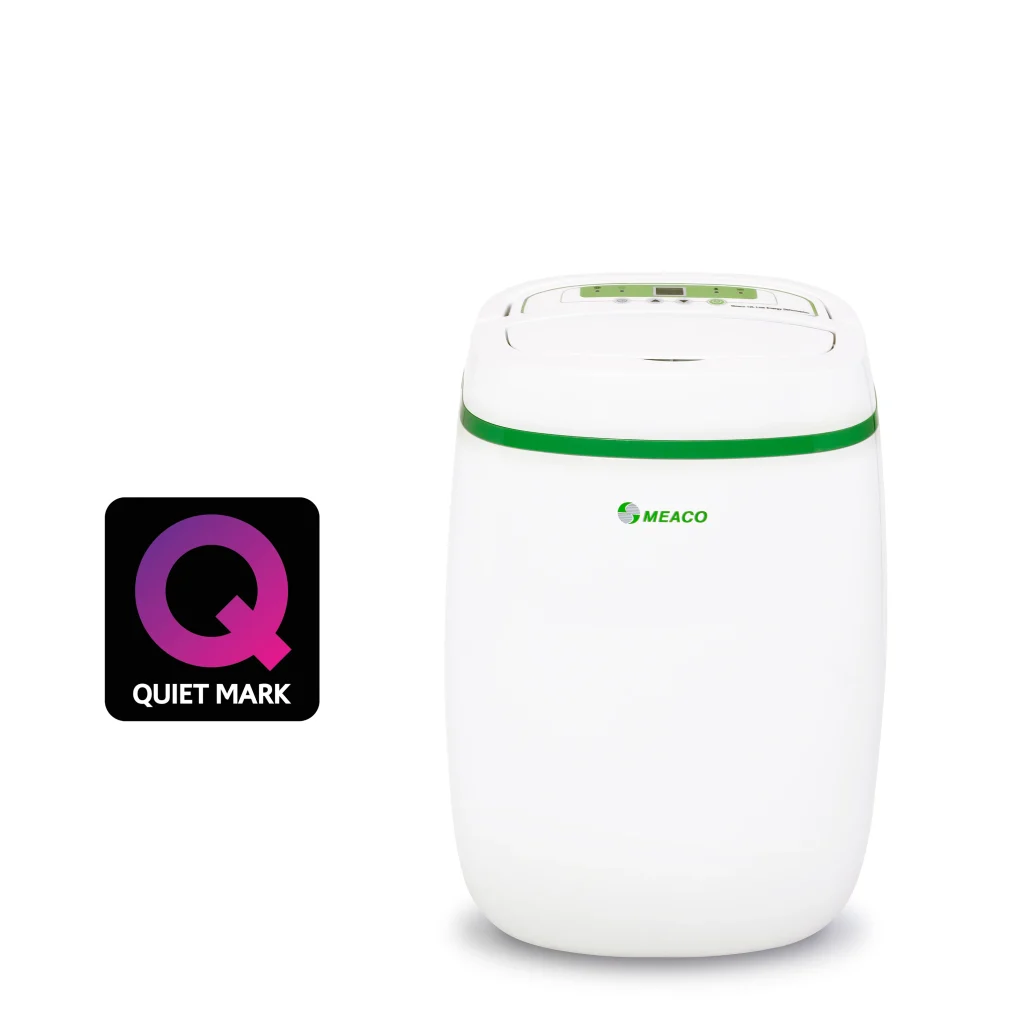
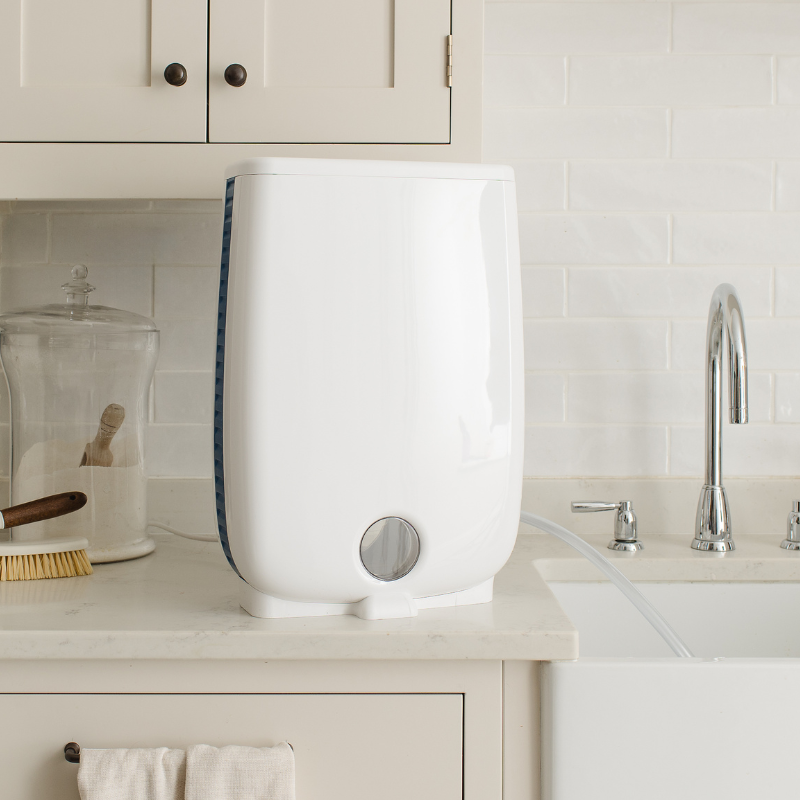





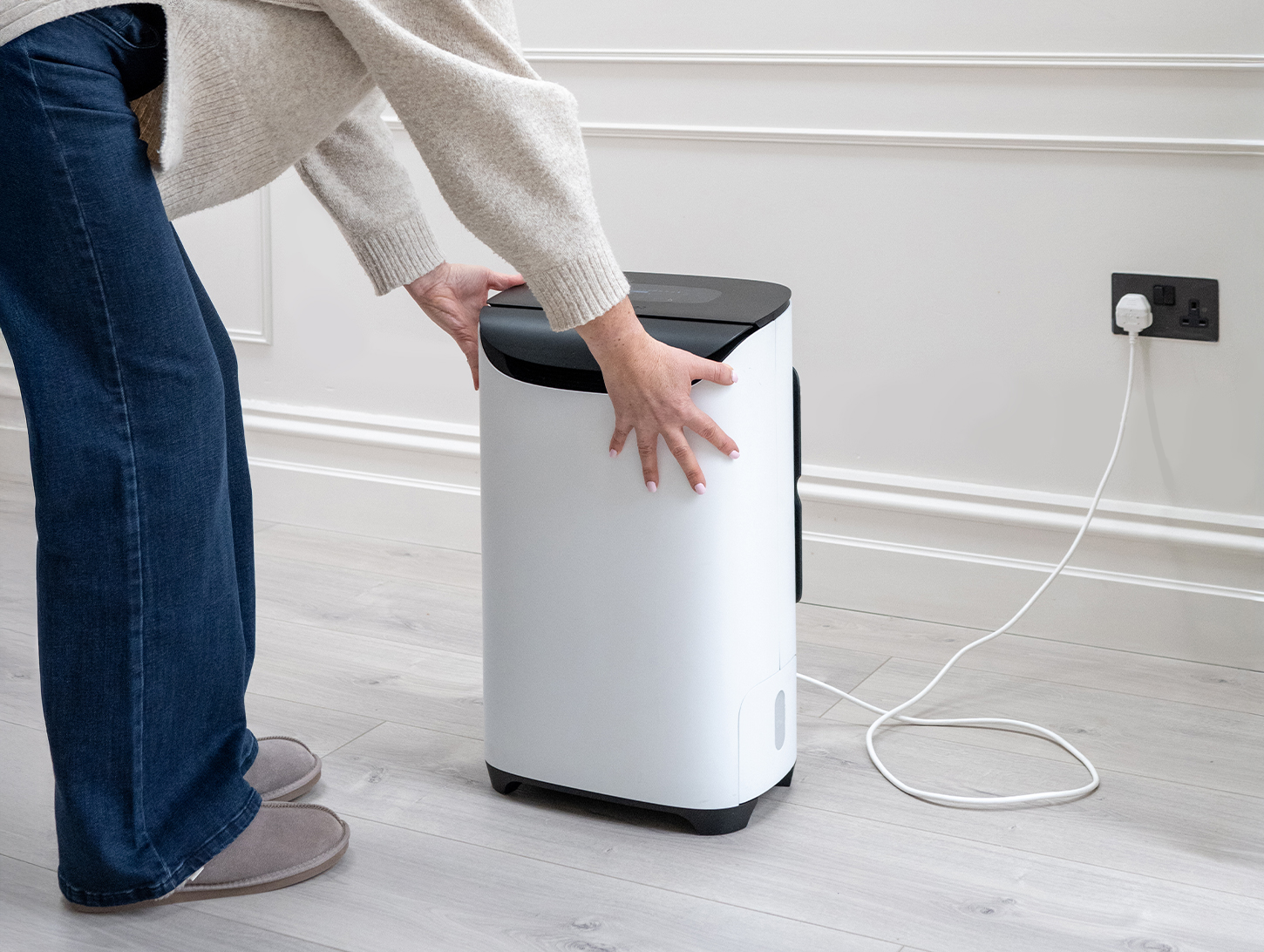
215 responses
I LIVE IN A GRADE TWO APARTMENT WITH CRITTAL SINGLED GLASSED WINDOWS MY PROBLEM IS BAD CONDENSATION IN THE MORNINGS HOW CAN I CURE THIS
Brian,
Single glazed Windows are always likely to suffer from condensation because they will have a lower surface temperature than the better insulated double glazed windows. A dehumidifier will remove the excess moisture from the air but they are not designed to remove all moisture from the air because that would be a waste of energy and would create an unhealthy atmosphere. Therefore a dehumidifier would be a sensible purchase that will bring the relative humidity down as low as is sensible which will greatly reduce or eliminate the condensation on the windows for the majority of the year. When the outside air temperatures drop low enough so that the surface temperature of the glass falls below 10C then you will get condensation on the windows. But by using a dehumidifier the amount of condensation will of been reduced and the house will feel warmer.
Hope this helps.
Regards
Chris
I have recently rented a 4-bed bungalow a mile from the sea near Bournemouth. It is now October, and the outside temp drops to around 10C give or take 5C, but the (warm-air) heating is not yet needed at all as the house is very well insulated. Sounds cosy, but though we open all the windows every day, which are covered in moisture, and leave a few open a little at night, there seems to be an increasing sense of dampness. The carpets don’t always feel totally dry, and papers even feel slightly damp. I googled de-humidifier and came up with your page which is very helpful indeed. However, one thing that you haven’t mentioned that I found on subsequent pages is the noise levels. Apparently a lot of people turn their de-humidifiers off at night so that they can sleep, which is precisely the period during which they need the de-humidifier to prevent condensation.
How noisy would you say they are, yourself, and would placing one in the dining room – far away from the bedrooms – most likely still allow a light sleeper to sleep well?
(And in practice, from your knowledge, would one de-humidifier possibly be adequate? Or at least helpful even for the furthest bedroom? Or would two be essential? And if so, have you got any other noise level reduction ideas?)
You have been very kind in answering questions, so I hope you won’t mind me asking you all these!
Anthony,
Thank you for your message. It certainly sounds like you need a dehumidifier. The mistake that many people make is that they try and use their dehumidifier in their bedroom. This leads to complaints about noise. If you have a Meaco DD8L dehumidifier and leave it on single fan speed then you will not be able to hear the noise at night. I would place it in the hallway and leave all of the internal doors open. If you like you can leave your bedroom door closed at night and open during the day.
During the day I would use it on the middle fan speed and with the extra background noise that happens during the day again you will not be able to hear it.
The DD8L is a desiccant dehumidifier and as such does not have a compressor and is therefore quieter than other dehumidifiers.
Hope this helps. call the office if you want more advice (01483 234900).
Chris
Hi Chris,
Can you tell me when and how I should use a dehumidifier?
Some people say only through summer, some say through winter so I am a bit confused by it all.
I have a bedroom that condenses quite badly and mold growth has occurred. I have cleaned away the mold but need to know how best to deal with the condensation. Should I just have my heating on during winter and vent via windows and just use the dehumidifier in the warmer summer months? or should I not have my heating on in winter and use a dehumidifier?
Completely baffled… Please advise… Also, how long should I run one for?
Thanks
Richard,
Things vary on a case by case basis. The summer months are the most humid and in countries whereby the weather becomes sticky on hot, humid days dehumidifiers are used to remove that sticky feeling. Basements suffer from damp problems in the summer because they are cooler than the rest of the house and mould grows when the warm, humid air hits the colder surfaces in the basement.
In the winter we close our windows and seal our houses up more. This means that we retain the moisture that we are generating in the house and it starts to build up. Heating the air does dry the air our but when this moisture laden air comes into contact with cold surfaces (windows) condensation occurs. Ventilating is an option but you are letting cold air in and the hot air that you have already heated will escape. this can be very costly.
This is why in Britain it is very common to use a dehumidifier during the Autumn and Winter.
Hope this helps. Any more questions then please do let me know or call the office on 01483 234900.
Chris
Hi,
I am considering buying one of these dehumidifiers for our 2 bedroom flat (120sqm). We have double glazing and get alot of condensation on the windows in the mornings within the winter months. I keep wiping the condensation on each window every morning and air the whole house. in the summer for 3 months we have no condensation issues whatsoever. I have a humidity meter which reads 70% or above from mid autumn to the end of winter.
My questions though:
– Will a medium size dehumidifier deal with the whole flat to keep it dry with relative humidity of less than 60%?
– While the dehumidifier is on, should all the windows be closed and would the flat need to be as air tight as possible for it to work at its best performance and do a good job much like the Heat Recovery Ventilation systems?
– Let’s say it’s used every night for 12 hours, from 6pm till 6am then off, will I need to air the whole house again in the morning? Or keep the windows closed?
Any help is appreciated.
Mat,
This is a very common application and one that we come across every day. You need the Meaco DD8L because it is small, light, quiet and very good at drying Laundry. All very important in a flat. Put it somewhere central and let the humidistat turn the dehumidifier off and on as required, it will only work when necessary. Keep the windows closed so that you are not trying to dry the outside air and leave it turned on all of the time.
Further information on flats can be found here – http://www.meaco.com/blog/?p=431
regards
Chris
Hi Chris, I have fitted wardrobes on an outside wall. My house have cavity wall insulation etc. I bought a load of hanging dehumidifier bags and they are filling up every 2 weeks, so I would consider the problem to be quite severe. I also have an additional downstairs shower room and my living room wallpaper now has damp spots moving upwards. I have had the property checked by a damp “expert” who said it is definitely condensation and not damp. It has been recommended that I have a unit fitting in the loft of my house, but I have heard mixed reviews about the effectiveness. The house is starting to smell very musty and I am literally tearing my hair out over it. Any advice would be much appreciated.
Lorraine
Lorraine,
Feel free to call me at the office to discuss if you wish (01483 234900). The problem is that you have too much moisture in the house and it is reaching the trigger point for condensation and mould growth. The solution is to reduce the amount of moisture by producing less or by mechanical intervention (ventilation, dehumidifier or air exchange unit in the loft).
The problem as I see it with the loft solution is similar to the issue with ventilation. The loft system works on the basis of pulling air in from outside at cold temperatures and relying on the fact that your loft is warmer than outside to dry the air coming in (so less effective in the spring/summer when mould growth can be at it’s fastest). The air itself is not dried at all and no moisture is actually removed from the air coming in (hence making it less effective outside of winter). This air is then pumped into the house via the loft hatch; the idea is that this new air will push out the air in the house leaving the air in the house dryer.
Problem is that in the winter you are paying to heat up air that the loft system is pushing to outside and then you have to heat up the air coming in from the loft all over again. So you end up paying to heat air over and over again. This plus it’s effectiveness in the summer puts me off.
A dehumidifier processes the air within the house, takes out water that you can see in a bucket and makes it cheaper for you to heat the house in winter.
Hope this helps, let me know if you have any more questions.
regards
Chris
Hi Chris.
I bought a Dehumidifier the other day and put it in the bedroom where I have the problem with condensation. It was in there for 10 hours and no water in the bucket. Humidity level was 64% at the time, had the fan at max and humidity at nearly max. Why did I not get water in the bucket. Iam new to all of this so many I was doing something wrong.
Regards
Colm
Colm,
It will be one of two reasons, either the relative humidity is not actually as high as 64%rh and you have a low surface temperature on the windows but not enough relative humidity in the air for the dehumidifier to collect anything, or the dehumidifier is faulty. Easiest way to check is to put the dehumidifier into the bathroom after a bath or a shower with the extractor off, window closed and door shut and then leave it in there on max for several hours. If you have water then the relative humidity in the bedroom is actually lower than you thought, if there is no water then the dehumidifier is faulty.
Let me know what happens.
regards
Chris
Hi Chis, i just moved to Porto Portugal & dealing with cold damp air in my flat. I have a 1 bedroom (600 sq ft) i have 3 windows huge tall windows with double pane glass 1 bedroom, 2 in kitchen living area. i just read about opening tge windows. If i buy a de- humidifier can you tell me what i need to purchase for my flat. Should i run it daily for how long?
Gail,
Look for a quiet machine with a dB of around 41dB and a capacity of 12L that you can run 24/7 with the humidistat set to 50%rh. Also use the dehumidifier to help dry the washing if you do not have a tumble dryer.
Chris
Hi chris, thanks for the info. I purchased a dehumidifier and must says its amazing how much water it extracts. I think my house moisture is a mixture of no window in bathroom (purchased a powerful extractor fan) kitchen hood that doesn’t actually vent anywhere, baby steriliser and rising damp oh and the mrs drying the clothes on the radiators haha my question is although the dehumidifier is great, how frequent should it be used? I find the humidity creeps back up in a day so I really need to use it every day for a few hours in the worst effected areas, is that normal?
Paul,
Your analysis is probably correct, with regards to the rising damp are you seeing damp patches on the wall no higher than window height? This article will help you in the identification of what is rising damp and what is condensation – http://www.meaco.com/damp.php
Set the dehumidifier to a mid point humidistat setting, on a Meaco dehumidifier that will be the Thumbs Up setting. This will ensure that the dehumidifier will dry the air before there is enough moisture in the air to create mould but it will not run all the time and your electricity usage will be minimised. Always use the dehumidifier to dry the laundry so that the moisture does not get a chance to escape around the house.
Hope this helps.
Regards
Chris
I have just purchased a dehumidifier rated at 16 litres per day but only getting 300 ml of liquid each day. Why so little?
House temperature about 20degrees C
Uk based detached house
Chris,
The dehumidifier is probably fine but based on the current relative humidity and the humidistat setting for the dehumidifier that is all that it needs to extract in order to reach the target setting. Think of it as a radiator, if it only has to increase the room temperature by 1°C you would not be expecting it to blast out heat at maximum capacity.
It will only extract 20 litres a day at it’s optimum conditions of 30°C and 80%rh.
Hope this helps.
regards
Chris
Hi – we have tenants in our home who won’t use the extractor fan in the bathroom because of the noise it creates in one of the bedrooms. We didn’t have an issue when we lived there because we opened the window and left doors around the house open too to keep the air circulating, but they keep all the doors closed for privacy, and don’t leave the window open for security in case someone forgets to close it. The result is a very mouldy bathroom, rusted towel rail and shower rail. Is it safe to put a dehumidifier actually in the bathroom? (plugged in outside in the hallway) Thanks
Simone,
Common problem that we get a lot of questions about. What you have to remember is that each family creates a different amount of moisture and winters vary greatly, the colder the winter the greater the problem because surface temperatures will be lower and windows will be opened less. It is a complicated situation.
To answer your question you should never use a 220 volt appliance in a wet area. If you leave the bathroom door open then the moisture will migrate out of the room and into the drier hallway. If you must plug it in the hallway and put the dehumidifier in the bathroom to give it a good drying out then please make sure that children are not around and everyone knows not to touch the dehumidifier with wet hands.
Chris
Hi Chris, I get really bad condensation in the winter, I’ve bought a humidity meter which says up stairs sometimes goes up to 80%, would a dehumidifier help and would one do the whole of up stairs, 3 bedrooms, any advice would be very welcome, thanks, Scott
Yes a dehumidifier will solve the problem, this is exactly what they do. Put the dehumidifier on the landing or at the bottom of the stairs and as long as you leave the internal doors open the damp will migrate towards the dehumnidifier and the air in the whole house will be dried.
Hi Chris,
I have been having a lot of mould and condensation issues in my small flat, in bedroom and lounge. I was thinking of purchasing a dehumidifier (http://www.amazon.co.uk/gp/aw/d/B0018LR2RE/ref=aw_ls__3?colid=XCESSKSHW71G&coliid=I1CJB43TZEN47T), do I need one in both rooms. Its a small flat so wasnt sure if one would be enough.
Sophie,
That dehumidifier will not help at all because it is a Peltier dehumidifier designed for use in a wardrobe. It will not solve the problem in the whole flat. You need a proper dehumidifier like the Meaco DD8L to deal with the amount of moisture that you will be generating in a flat.
The DD8L is popular in a flat because it is light, quiet, small and very good at drying laundry (often the cause of damp problems in flats). You will find a dedicated article about using a dehumidifier in a flat here – http://www.meaco.com/blog/?p=431.
Hope this helps.
Chris
Hi Chris. My builder has gone bust mid refurb. We are not living at property and there is no heating. Windows are dripping wet and it’s cold. I have started to get mould on new part a of house where walls were plastered months ago when was warmer. I’m going to get some electtic fan heaters to warm house up. Should I rent an dehumidifier alongside heating the house or shall I open window for few hours then heat the house. I can’t run dehumidifier and heater at the same time as I’m running off a extension lead as there is no fuse box installed yet.
Richard,
Sorry to hear that. I would get the electrics fixed as a priority and then get a dehumidifier and some heat in there. A 20L dehumidifier running 24/7 will make a big difference.
Chris
I have asthma and use my humidifier a lot in my bedroom but I see I should be moving it throughout the small flat. Question is- can I put on central heating at same time? I live in Scotland brrr. Thanks I’m advance.
Helen,
You can certainly put your heating on and you should stay comfortable. Just be aware that the warmer the air the drier the air will be.
Chris
I’m a large three bedroom house should I opt for a central dehumidifier rather than individual ones . My concern is how to extract water from a down stairs area if the central dehumidifier only extracts the upstairs ?
That is the idea, place one dehumidifier somewhere central and then the damp air around the house will migrate towards the dry spot around the dehumidifier. Just leave the internal doors open and all will be fine.
Dehumidifiers are quite expensive I made the decision to go with air conditioning you will never look back in comparison to her dehumidifier air conditioning of significantly better job and of course whether it’s in dehumidify mode or air-conditioning mode it will still remove much more water from the air than any dehumidifier will especially a small peltier Effect one or even one of those large ones no match for a nice wall mounted air conditioning unit and that’s what I recommen
Air con will only effect the one room (unless you have an open plan space) and will never extract as much water as a proper dehumidifier as that is not it’s primary function. It will also not help to dry laundry and cannot be moved around the house if required. We have wall mounted air conditioning in the loft conversion and they are excellent for heating and cooling those rooms, but they are not a solution to whole house moisture issues. the comment about peltier is correct, which is why we don’t sell them!
I am actually baffled as my humidity is very low at the moment 42 today. I opened all my windows as it was milder to get fresh air in .The humidity remained low. Yet in the evening 1 window had unusual condensation. I do use a dehumidifier. However no need as it’s logged to stop at 50 degrees humidity . Plus no showers etc caused this .
Either the window in question was not seeing the dry air that the rest of the house was benefiting from because of a curtain/blind being down or a door being closed or that window has a colder surface temperature because it is older or perhaps north facing.
regards
Chris